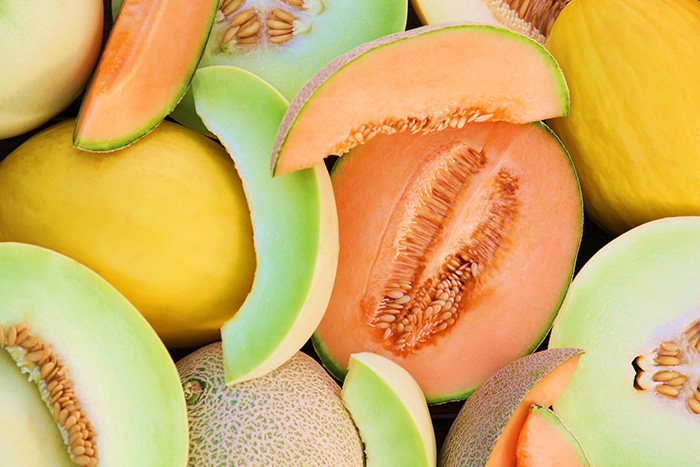
(Credit: Adobestock images)
With fruits having sweet and juicy pulp, melons are a summertime delight whether freshly picked or cooled in a refrigerator. August is a perfect month to enjoy melons as they ripen in the garden, or from the abundance of locally-grown melons that can be found at roadside stands and farmers’ markets. More than a dessert or snack, they can be used as an ingredient in salads, salsas, side dishes, entrees, and drinks.
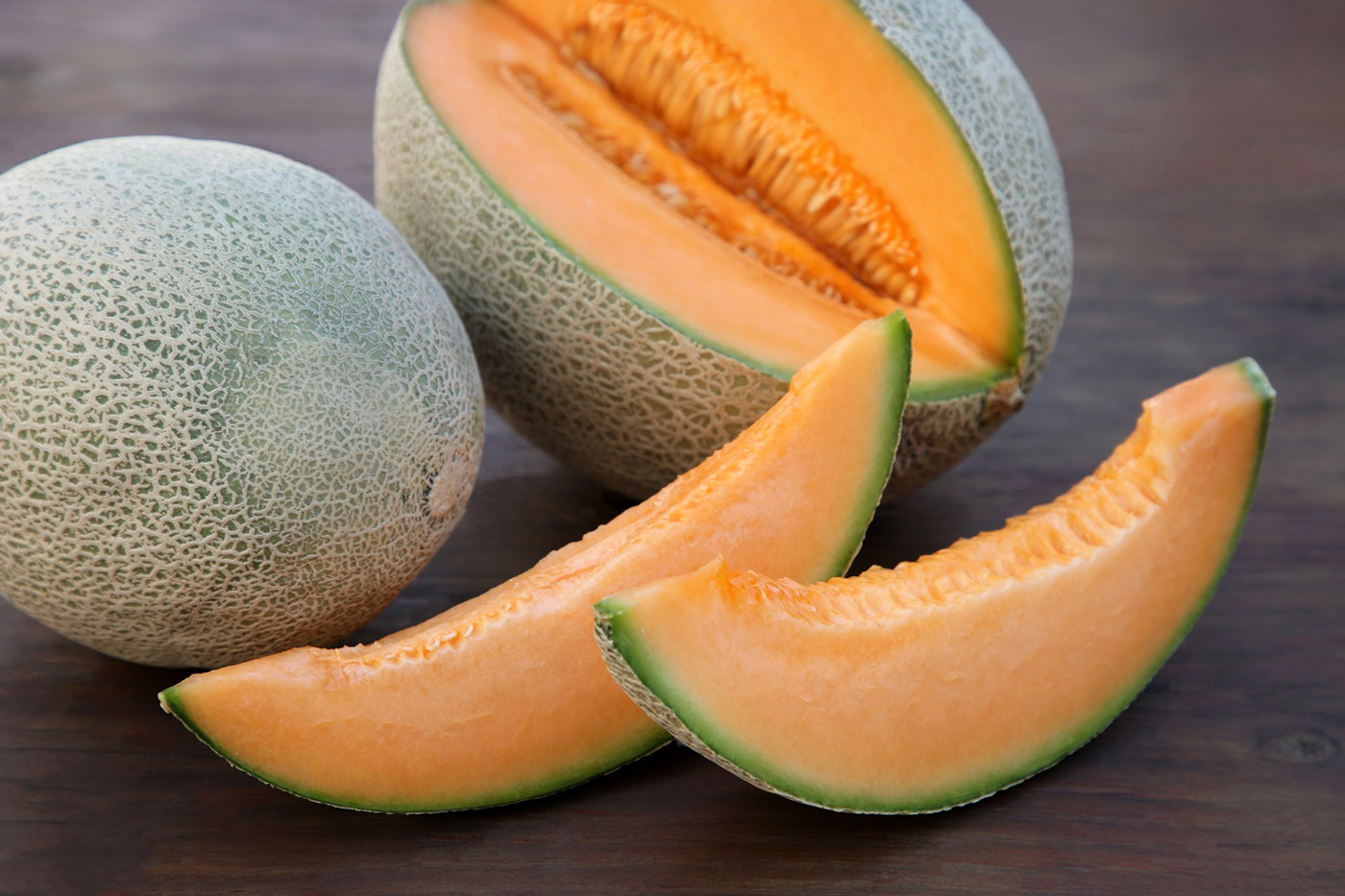
Melons are prized for their sweet, aromatic pulp and can be used in a variety of culinary ways. (Credit: Adobestock images)
By definition, melons are "the large round fruit of various plants of the gourd family, with sweet pulpy flesh and many seeds." They are believed to have originated in the hot valleys of southwest Asia—specifically Persia (Iran) and India. The word melon derives from the word melopepo, which is the Latinization of the Greek mēlopepōn. Early American settlers grew cultivars of honeydew and casaba melons back in the 1600s. Yet, only in recent times have many more varieties become available, often out of season, in grocery stores.
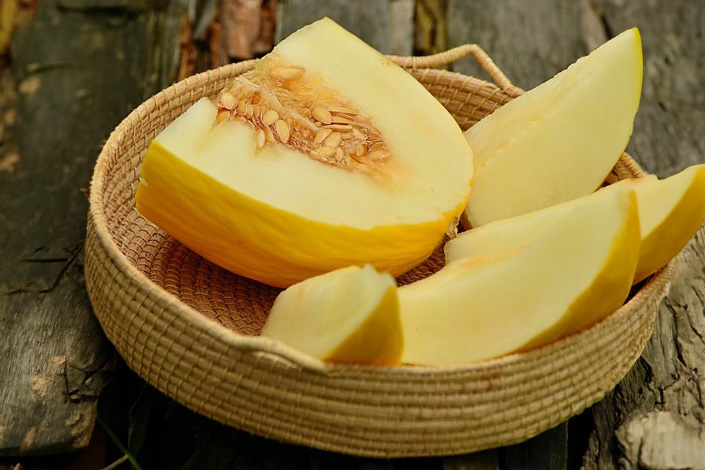
The term "melon" is somewhat generic and refers to any number of cultivars of Cucumis melo. Pictured is canary melon, known for its bright yellow rind and nearly white pulp.) (Credit: Pixabay)
Melons are most productive in regions with long, warm growing seasons. A vining plant, melons are monecious, meaning they produce both male and female flowers on the same plant. Pollination usually is accomplished by bees. Most melons ripen in late summer or early‑ to mid‑fall. They range in size from slightly larger than a softball to hefty 15-pound varieties, and in color—both outside and inside, with pale grayish‑white to very dark green skin and the palest yellow to the brightest orange and green flesh. Their seeds fill the hollow center of the fruit which botanically is known as a pepo.
All melons are members of the Cucurbitaceae plant family, also known as the cucurbit or gourd family. This large family has more than 100 genera, including cucumbers, gourds, pumpkins, all types of squash, and even loofahs. "Melons" fall into two genera: Cucumis and Citrullus. Cucumis comprises all melons except for watermelon, which is Citrullus —a totally different genus. As a group, all Cucumis melo melons can be called muskmelons or melons.
Taxonomically, Cucumis melo is further divided into different groups including cantaloupensis, reticulatus and inodorous. Cantaloupensis is the true cantaloupe, which is medium sized, warty or scaly, common in Europe, but not grown commercially in America. The reticulatus group of melons is commonly grown and easily identified by its netted skin and is called netted or summer melon. This group includes Galia and Charentais melons as well as what we call cantaloupe. In America, the terms "muskmelon" and "cantaloupe" are used interchangeably, yet "cantaloupe" is more common. When ripe, these melons are aromatic and the vine "slips" off of the fruit. The inodorous melons are known as smooth or winter melons and can be identified by their smooth skin (rind). At maturity, they lack an aromatic or musky odor and do not slip from the vine. Members of this group include the casaba, crenshaw, Christmas, canary, and honeydew melons.
The following is a list of different types of melons and their distinguishing attributes.
- Ananas Melons (Middle Eastern melons) are oval shaped with medium‑fine netting over pale green to orange rind. They have very sweet, aromatic white flesh. One variety has orange‑pink flesh. Average weight of this group is three to four pounds.
- Athena Cantaloupes (Eastern U.S. cantaloupes) are early maturing, oval‑shaped; Athenas are yellow‑orange summer melons with firm, thick, yellow‑orange flesh. Their skin is slightly sutured with coarse netting. Average weight of this group is five to six pounds. Left on the vine or harvested, their flesh remains firm.
- Canary Melons have bright yellow rinds and an oblong shape. Inside, their pale, cream‑colored flesh is juicy, and their flavor is very mild.
- Casaba Melons have an oval shape with a pointy end. That coupled with their wrinkled yellow skin sets casabas off from other melons. Weighing in at four to seven pounds Casabas are some of the largest melons. Their pale, almost white flesh is extremely sweet.
- Charentais Melons (French Charentais) are French melons identifiable by their smooth, gray, or gray‑blue rinds with sutures; they have orange flesh.
- Christmas Melons (Piel de Sapo and Rochet) have a football shape, and weigh upwards of five to eight pounds. Cutting through the yellow to green mottled rinds of this group reveals the palest orange or light green flesh depending upon the variety. Christmas melons have sweet flesh.
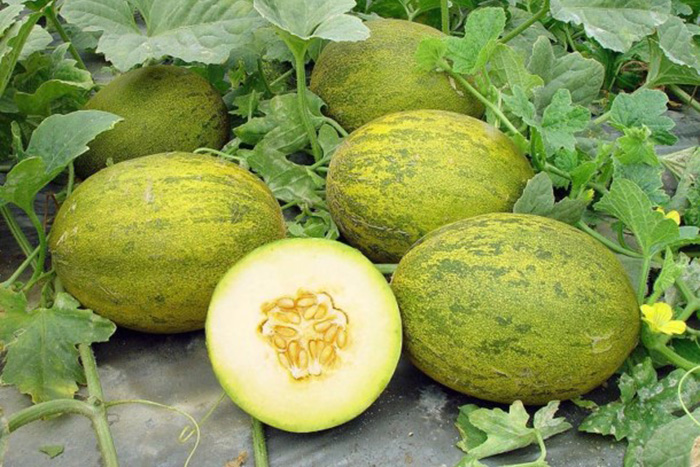
Christmas melons are shaped like a football and are known for their very sweet flavor and storage ability. Pictured is 'Lambkin' which received the coveted All American Selections award. (Credit: AAS Selections)
- Crenshaw Melons are a casaba cross with a slightly more oblong shape, and weight at least five pounds. Their slightly wrinkled green rind ripens to yellow. Inside, their flesh is pale peachy orange. Crenshaws has a strong, spicy aroma.
- Galia Melons (Israeli melons) have netted rinds similar to cantaloupes but are paler in color. Their sweet pale green to almost white flesh has the consistency of a honeydew with what has been described as a spicy‑sweet or banana‑like aroma. When ripe, they slip from the vine.
- Honeydews have smooth, white to greenish‑white rinds (some may be yellow) and open to reveal refreshingly sweet flesh that may be green, white, or orange. Honeydew texture is similar to a cantaloupe, but the flavor is more subtle and sweet.
- Muskmelons are the familiar American cantaloupes with orange, sweet flesh and netted skin.
- Oriental Melons are small (weighing a little more than a pound), elongated yellow melons with white sutures, and sweet, pale peach to white flesh. Because the seeds of this group are so small and the rind so thin, the entire melon can be eaten.
- Persian Melons are bigger than cantaloupes and have a dark green rind with light brown netting. As they ripen, their rind turns to light green. Their bright pink‑orange flesh has a delicate flavor. Unlike most melons in the reticulatus group, Persian melons do not slip from the vine when mature.
- True Cantaloupe, named for the town of Cantalupo near Rome, Italy has rough‑warty (not netted) skin. This is the European cantaloupe that is rarely grown in America.
- Winter Melon is the all-inclusive name for the long‑season, long‑keeping melons, including crenshaw, casaba, canary, and Christmas melons. These melons keep for a month or more at room temperature.
Melons are warm‑season plants which thrive in temperatures of 70° to 80° F. They prefer slightly acid soil with a pH between 6.0 and 6.5. Melons are thirsty and hungry plants, so be prepared to provide ample soil moisture and plant nutrients for them. They can be directly seeded in the garden but only after the soil warms and the danger of frost has passed. Plant melons in “hills” consisting of three to five seeds two inches apart and about one-half inch deep and water them well. Space hills two to three feet apart with rows and five feet between rows. Once the plants have two sets of true leaves, thin out the smaller or weaker plants, leaving the two strongest to grow on.
Some gardeners, especially those in colder climates, plant melons through black plastic mulch. The dark plastic absorbs heat, warms the soil early, conserves moisture, controls weeds, keeps some pests and diseases away, and makes harvesting easier and cleaner. The planting date for melons also can be advanced through the use of hot caps or synthetic row covers. The latter is preferred since it can be fastened over small wire hoops placed over the row to form a cloche or “low tunnel.”
Melons also can be started indoors. This practice along with the use of row covers allow gardeners to advance the season by several weeks. Sow the seeds indoors in a container such as a peat pot filled with a soilless growing medium, about 10‑15 days before planting time. Harden off the plants for at least a week before planting them. Melons are cold‑sensitive; pay attention to both the air and soil temperatures before transplanting. Water well with transplant fertilizer solution after planting.
Melons need a minimum of between one and two inches of water per week. If supplemental irrigation is required, melons should be watered in the morning, ideally at soil level using drip irrigation, so the leaves can dry before evening. This helps to prevent fungal diseases.
As mentioned above, melons are relatively heavy feeders. Fertilizer (and lime) applications should be based on soil tests. As a general rule, two pounds of actual nitrogen, two pounds of phosphorus (P2O5) and three pounds of potassium (K2O) per 1000 square feet of garden space is adequate for good yields. It is wise to split the nitrogen into two applications-- one-half applied before planting and one-half applied when the vines begin to “run.”
If plants begin to flower but do not set fruit, do not be alarmed. The first flowers produced by the vines are male (pollen‑bearing) and cannot set fruit. The female (pistillate) flowers will appear later and (after pollination) develop melons. Female flowers are distinguished by the tiny bulb at the base of the flower. If the female flower isn’t pollinated, the flower and fruit will eventually fall off the vine.
The best and sweetest melons ripen when the weather is hot and dry. Melons need sufficient moisture while growing and sizing fruit but, prior to harvest, best flavor will occur if the plant is grown on the "dry" side. Cut back on watering melons about three weeks prior to harvesting the main crop.
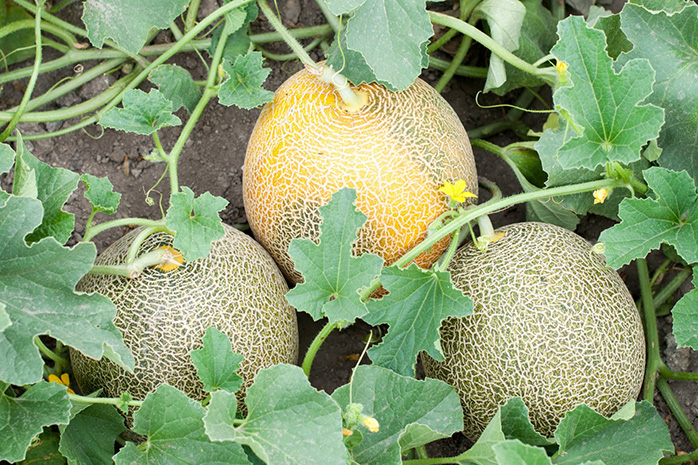
Melons are a warm weather vegetable which require a long growing season to develop sweetest flavor. (Credit: Adobestock Images)
Melons need heat to ripen properly. Most summer melons are fragrant when ripe. Sniff the skin; if you smell the flavor of the melon (the senses of smell and taste are interrelated), it is ripe for the picking. Another indicator for ripeness is when the stem separates (slips) easily where the vine attaches to the fruit. Cantaloupes are mature when the rind changes from green to tan‑yellow between the veins.
Honeydew, crenshaw, and other winter melons are ready to harvest when they turn completely white or yellow and the blossom end is slightly soft to touch. Since they do not slip, cut the melons from the vine. They will continue to ripen for several days at room temperature once they are picked.
Melons are susceptible to a number of pests and diseases, some of which may be more prevalent in one area than another. Some of the most common problems include diseases such as Alternaria leaf spot, powdery mildew, anthracnose, downy mildew and mosaic virus. Insect pests include cucumber beetles and aphid. Prevention is the key to disease management. If transplants are purchased, inspect them thoroughly before moving them into the garden. Be fastidious in fall cleanup; get rid of all parts of the plant, leaving bare soil that you can mulch, or plant for winter. At the first sign of disease, remove the infected part. Do not plant cucurbits in the same place within three years of the last planting (crop rotation). With melons, an ounce of prevention may be worth hundreds of pounds of cure in healthy, delicious fruit.
Pesticides labeled for use on melons can be found at the following web address: http://extension.missouri.edu/explore/agguides/hort/index.htm. Look for guides G6202, G6203 and PS9.
Melons can be grown in containers for gardeners with limited space. Select a large container, a dwarf melon variety, and the proper growing medium. Soilless blends of peat, vermiculite and perlite are preferred. Make certain the container has drainage and fill it with moistened growing medium. Melons can be allowed to “ramble” or trained to grow up a trellis if you wish, supporting the fruit with nets made from a porous material.
Credit: Adapted from an article by the National Garden Bureau